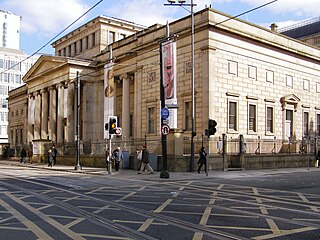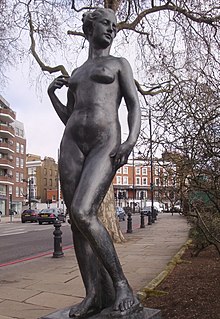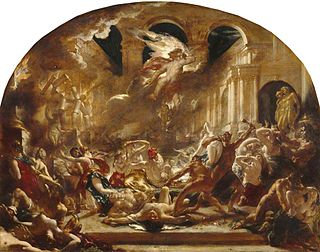 W
WManchester Art Gallery, formerly Manchester City Art Gallery, is a publicly owned art museum on Mosley Street in Manchester city centre. The main gallery premises were built for a learned society in 1823 and today its collection occupies three connected buildings, two of which were designed by Sir Charles Barry. Both Barry's buildings are listed. The building that links them was designed by Hopkins Architects following an architectural design competition managed by RIBA Competitions. It opened in 2002 following a major renovation and expansion project undertaken by the art gallery.
 W
WAtalanta is a statue by English sculptor Francis Derwent Wood. It depicts a naked woman, standing in a contrapposto position, glancing to her left, with her left hand by her side and right hand raised to her shoulder. The subject is Atalanta, a virgin huntress from Greek mythology; she may be preparing for the foot race she used as an obstacle to prevent suitors securing a marriage.
 W
WAutumn Leaves (1856) is a painting by John Everett Millais exhibited at the Royal Academy in 1856. It was described by the critic John Ruskin as "the first instance of a perfectly painted twilight." Millais's wife Effie wrote that he had intended to create a picture that was "full of beauty and without a subject".
 W
WCaptive Andromache is an oil painting on a 197 cm × 407 cm canvas by Frederic Leighton produced in ca. 1888. It was purchased by Manchester City Council for £4,000 from the artist in 1889. It now hangs in Manchester Art Gallery
 W
WCromwell, Protector of the Vaudois (1877) is a painting by Ford Madox Brown which depicts Oliver Cromwell in conversation with John Milton dictating a letter to Andrew Marvell protesting at the Piedmontese Easter massacre (1655), an attack on the Vaudois (Waldenses), a persecuted Protestant sect in Piedmont, northern Italy. It was Brown's second Cromwell painting, following Cromwell on his Farm (1875).
 W
WThe Derby Day is a large oil painting showing a panoramic view of The Derby, painted by William Powell Frith over 15 months from 1856 to 1858. It has been described by Christie's as Frith's "undisputed masterpiece" and also "arguably the definitive example of Victorian modern-life genre".
 W
WThe Destroying Angel and Daemons of Evil Interrupting the Orgies of the Vicious and Intemperate, also known as The Destroying Angel and Daemons Inflicting Divine Vengeance on the Wicked and Intemperate and as The Destruction of the Temple of Vice, is an oil painting on canvas by English artist William Etty, first exhibited in 1832. Etty had become famous for nude paintings, and acquired a reputation for tastelessness, indecency and a lack of creativity. With The Destroying Angel he hoped to disprove his critics with an openly moral piece. The painting is 127.8 cm by 101.9 cm and depicts a classical temple under attack from a destroying angel and a group of daemons. Some of the humans appear dead or unconscious, others flee or struggle against the daemons.
 W
WThe Hireling Shepherd (1851) is a painting by the Pre-Raphaelite artist William Holman Hunt. It represents a shepherd neglecting his flock in favour of an attractive country girl to whom he shows a death's-head hawkmoth. The meaning of the image has been much debated.
 W
WHylas and the Nymphs is an 1896 oil painting by John William Waterhouse. The painting depicts a moment from the Greek and Roman legend of the tragic youth Hylas, based on accounts by Ovid and other ancient writers, in which the enraptured Hylas is abducted by Naiads while seeking drinking water.
 W
WThe Light of the World (1851–1853) is an allegorical painting by the English Pre-Raphaelite artist William Holman Hunt (1827–1910) representing the figure of Jesus preparing to knock on an overgrown and long-unopened door, illustrating Revelation 3:20: "Behold, I stand at the door and knock; if any man hear My voice, and open the door, I will come in to him, and will sup with him, and he with Me". According to Hunt: "I painted the picture with what I thought, unworthy though I was, to be by Divine command, and not simply as a good Subject." The door in the painting has no handle, and can therefore be opened only from the inside, representing "the obstinately shut mind". Hunt, 50 years after painting it, felt he had to explain the symbolism.
 W
WManfred on the Jungfrau is an 1842 oil-on-canvas painting by Ford Madox Brown. It is inspired by Act I Scene II of Lord Byron's dramatic poem Manfred, probably most particularly the following: ... And you, ye crags upon whose extreme edge I stand, and on the torrent's brink beneath Behold the tall pines dwindled as to shrubs In dizziness of distance, when a leap, A stir, a motion, even a breath, would bring My breast upon its rocky bosom's bed To rest for ever – wherefore do I pause? ... Thou winged and cloud-cleaving minister, Whose happy flight is highest into heaven, Well may'st thou swoop so near me ... ... How beautiful is all this visible world! How glorious in its action and itself!
 W
WMusidora: The Bather 'At the Doubtful Breeze Alarmed', also known as The Bather, is a name given to four nearly identical oil paintings on canvas by English artist William Etty. The paintings illustrate a scene from James Thomson's 1727 poem Summer in which a young man accidentally sees a young woman bathing naked, and is torn between his desire to look and his knowledge that he ought to look away. The scene was popular with English artists as it was one of the few legitimate pretexts to paint nudes at a time when the display and distribution of nude imagery was suppressed.
 W
WThe Scapegoat (1854–1856) is a painting by William Holman Hunt which depicts the "scapegoat" described in the Book of Leviticus. On the Day of Atonement, a goat would have its horns wrapped with a red cloth – representing the sins of the community – and be driven off.
 W
WThe Shadow of Death is a religious painting by William Holman Hunt, on which he worked from 1870 to 1873, during his second trip to the Holy Land. It depicts Jesus as a young man prior to his ministry, working as a carpenter. He is shown stretching his arms after sawing wood. The shadow of his outstretched arms falls on a wooden spar on which carpentry tools hang, creating a "shadow of death" prefiguring the crucifixion. His mother Mary is depicted from behind, gazing up at the shadow, having been looking into a box in which she has kept the gifts given by the Magi.
 W
WThe Sirens and Ulysses is a large oil painting on canvas by the English artist William Etty, first exhibited in 1837. It depicts the scene from Homer's Odyssey in which Ulysses (Odysseus) resists the bewitching song of the Sirens by having his ship's crew tie him up, while they are ordered to block their own ears to prevent themselves from hearing the song.
 W
WStages of Cruelty is an oil-on-canvas painting by Ford Madox Brown. He worked on the painting over an extended period, from 1856 to 1890. It is held by the Manchester Art Gallery.
 W
WVictory O Lord! is an 1871 painting by John Everett Millais depicting Moses, Aaron and Hur during the Battle of Rephidim against the Amalekites. Along with his landscape Chill October it represented a major turning point in Millais career.
 W
WWork (1852–1865) is a painting by Ford Madox Brown that is generally considered to be his most important achievement. It exists in two versions. The painting attempts to portray, both literally and analytically, the totality of the Victorian social system and the transition from a rural to an urban economy. Brown began the painting in 1852 and completed it in 1865, when he set up a special exhibition to show it along with several of his other works. He wrote a detailed catalogue explaining the significance of the picture.